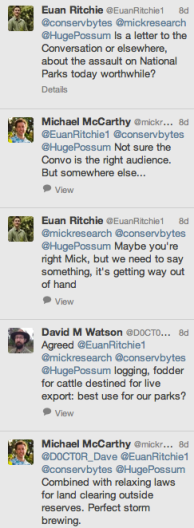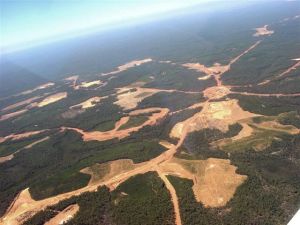 It’s interesting when a semi-random tweet by a colleague ends up mobilising a small army of scientists to get pissed off enough to co-write an article. Euan Ritchie of Deakin University started it off, and quickly recruited me, Mick McCarthy, David Watson, Ian Lunt, Hugh Possingham, Bill Laurance and Emma Johnston to put together the article. It’s a hugely important topic, so I hope it generates a lot of discussion and finally, some bloody action to stop the rapid destruction of this country’s national parks system.
It’s interesting when a semi-random tweet by a colleague ends up mobilising a small army of scientists to get pissed off enough to co-write an article. Euan Ritchie of Deakin University started it off, and quickly recruited me, Mick McCarthy, David Watson, Ian Lunt, Hugh Possingham, Bill Laurance and Emma Johnston to put together the article. It’s a hugely important topic, so I hope it generates a lot of discussion and finally, some bloody action to stop the rapid destruction of this country’s national parks system.
Note: Published simultaneously on The Conversation.
—
It’s make or break time for Australia’s national parks.
National parks on land and in the ocean are dying a death of a thousand cuts, in the form of bullets, hooks, hotels, logging concessions and grazing licences. It’s been an extraordinary last few months, with various governments in eastern states proposing new uses for these critically important areas.
Australia’s first “National Park”, established in 1879, was akin to a glorified country club. Now called the “Royal National Park” on the outskirts of Sydney, it was created as a recreational escape for Sydney-siders, with ornamental plantations, a zoo, race courses, artillery ranges, livestock paddocks, deer farms, logging leases and mines.
Australians since realised that national parks should focus on protecting the species and natural landscapes they contain. However, we are now in danger of regressing to the misguided ideals of the 19th Century.
Parks under attack
In Victoria, new rules will allow developers to build hotels and other ventures in national parks. In New South Wales, legislation has been introduced to allow recreational shooting in national parks, and there is pressure to log these areas too.
Late last year, NSW announced a new trial to re-instate grazing in the new Millewa National Park and other reserves, following Victoria’s unsuccessful attempt to allow grazing in the Alpine National Park.
And just this week, the Queensland government passed new laws that allow graziers tofeed their stock in national parks during droughts.
 It’s not just the land that’s under assault. NSW recently lifted bans on shore-based recreational fishing in most state marine sanctuaries. Coastal marine parks in Australia are mostly young, small (particularly the sanctuary zones), and poorly resourced. But they are vital for regulating human activities and making coastal ecosystems resilient to pollution, invasive species, resource extraction and climate change.
It’s not just the land that’s under assault. NSW recently lifted bans on shore-based recreational fishing in most state marine sanctuaries. Coastal marine parks in Australia are mostly young, small (particularly the sanctuary zones), and poorly resourced. But they are vital for regulating human activities and making coastal ecosystems resilient to pollution, invasive species, resource extraction and climate change.
The picture is grim and set to get worse. In Queensland and Victoria, land clearing laws (outside of national parks) are being “relaxed”, with at least two major impacts. First, it will place an even higher value on our reserves, as more land is cleared and further degraded. Second, it will decrease connectivity between remaining patches of native vegetation, further threatening species that require large, connected habitats.
Set against a background of rapidly changing climates (and associated changes in storm and fire frequency, droughts and floods), many imperilled species will face range contractions at best, and full extinction at worst.
Parks already doing too little
Why should all this matter?
It’s widely acknowledged that our current reserve system and efforts to conserve our native biodiversity are eminently praiseworthy, but hopelessly inadequate. Indeed, prolonged government failure to implement existing environmental laws and draw up plans for threatened species has recently resulted in court action.
The problem isn’t limited to Australia. Biodiversity in many protected areas around the world is declining due to encroaching threats from surrounding areas. There is no free lunch; as parks suffer, their biodiversity suffers too.
Management interventions such as feral animal control, fire management and at times,grazing management, can be useful tools to achieve conservation goals in some circumstances. However, these need to be based on the best available ecological knowledge and practice and be aimed at conserving biodiversity. This is not the motivation for any of the recent changes.
Exploitation of our parks, without scientific evidence for positive biodiversity outcomes, will hasten losses. These areas need to be in the best shape possible to cope with the intensifying pressures imposed by a disrupted climate and likely increases in the frequency of species invasions.
Australia’s rich biodiversity is one of the few things our country has that is truly, globally unique. It is worth billions of dollars to our economy, and provides crucial natural services that are not easily replaced. Beyond their value to plants and animals, our national parks, wild places, and nature in general, are “good for us”.
Desperate times call for smarter measures
To illustrate how we, and the governments representing us, are failing to make use of the best available science to aid park management, and the consequences this has, we draw attention to two issues: grazing and pest animal control.
Nobody questions the stress graziers face when their stock begins to starve as drought intensifies in parts of southern and eastern Australia. But simply opening the fences to national parks is a dangerous precedent that provides, at best, a Band-Aid solution to a recurring problem.
Moving stock from pastures to parks increases the risk of spreading weeds and further degrading natural habitats for birds and mammals, as well as sensitive water resources on which we and our livestock depend.
The current trend in drought-relief programs is helping farmers prepare for droughts. We no longer rely on emergency measures to cope with droughts that are expected and recurrent. Opening parks to grazing does not fit this model.
Australia needs to get smarter. We should do more to encourage flexibility in our agricultural and aquaculture systems. Why don’t we produce animals better suited to the unique Australian conditions?
Making better use of Australian species could also help us deal with the pest animals, overabundant herbivores (goats, camels, buffalo, deer and kangaroos) and introduced predators (cats and foxes) overrunning our parks. We have been using bullets and poison for a long time, with little evidence for an overall gain. In some cases, this approach has generated new problems.
In many regions, our best available weapon to control pest animals is the dingo. Abundant research now demonstrates that dingoes strongly limit goat, kangaroo and fox populations. Dingoes are an unrelenting and ultimately free service.
Dingoes therefore provide the perfect example of how we can start making better use of our native species to protect biodiversity more broadly, build more resilient landscapes and shift our approach from the reactive, ineffective, costly and interventionist approaches we often see at present, to more proactive, longer-term, integrated and effective conservation and management solutions.
Our parks are the last vestiges of Australian nature – a final refuge for our irreplaceable biodiversity and ecosystems. A return to the outdated views of the 19th century – when parks were little more than playgrounds for city dwellers to escape the urban malaise – would run counter to everything that Australians have learnt about environmental conservation in the last 150 years.



[…] http://www.abc.net.au/news/2016-09-19/whale-watcher-terry-hardy-tells-his-tale-of-remote-living https://conservationbytes.com/2013/05/24/our-national-parks-must-be-more-than-playgrounds-or-paddock… Why Lyreades? – @carolprobets matthew-canavan-barnaby-joyce-nationals-great-things […]
LikeLike
[…] continuing since colonial times, feral predators and herbivores blanketing the continent, inadequate protected areas, piss-weak policies and a government at war with its own environment. Despite a few recent wins in […]
LikeLike
[…] Implores the Commonwealth Government not to devolve national oversight of industrial and urban development potentially exacerbating the status of Australia’s threatened species. The Government should not allow individual Australian states to weaken or overturn national legislation such as the Environmental Protection and Biodiversity Conservation Act 1999 given the recent trends for state governments to relax laws for vegetation clearing and to allow industrial activities such as logging, grazing, fishing and mining in ‘national’ parks and…. […]
LikeLike
[…] year we even got to work together on a couple of things, further testament to combining the powers of social media and […]
LikeLike
[…] for state governments to rollback protection in national parks, including allowing logging, grazing, fishing and […]
LikeLike
Good post. I pinned, stumbled, tweeted, and scooped it (see the scoop at http://scoop.it/t/ecoscifi).
“Death by a thousand cuts” is apt for what happens to parks and open space everywhere.
Thank you.
Garry
LikeLike
Reblogged this on for Biodiversity's sake!.
LikeLike
[…] would ban all industrial and consumptive activities from the protected area network (e.g., livestock grazing, timber harvest, fishing, […]
LikeLike
[…] a pathetic collapse of its vertebrates. Add all this to our governments’ charge to remove protections of our national reserve system, and you can see that we have to do so very much more. Biodiversity corridors are another potential […]
LikeLike
[…] In Victoria, for instance, land developers are now being allowed to build hotels and other ventures in national parks. In NSW, recreational shooting and possibly logging will be allowed in parks if new legislation is passed. In NSW’s marine parks, bans on shore-based recreational fishing are being lifted [see previous post here]. […]
LikeLike
[…] protected areas losing their biodiversity, and national reserve systems [at least, in Australia] dying a death of a thousand cuts. It’s not just the biodiversity itself that’s suffering – society is losing […]
LikeLike
[…] the continuing theme of the demise of laws designed to protect Australian biodiversity (see here, here and here), I’m reproducing our latest Nature Correspondence on the issue. I know this […]
LikeLike
[…] our The Conversation article a few weeks ago about the rapid demise of national parks in Australia, a few of us (me, Euan Ritchie & Emma Johnston) wrote a follow-up piece on the […]
LikeLike
[…] Our national parks must be more than playgrounds or paddocks (conservationbytes.com) […]
LikeLike
More specifically on the Queensland environmental onslaught here.
LikeLike
[…] on The Conversation and is authored by Euan Ritchie, William Laurance, Corey Bradshaw (re-blogged on his site), David Watson, Emma Johnston, Hugh Possingham, Ian Lunt and QAECO’s Mick McCarthy […]
LikeLike